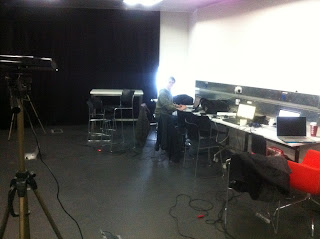Motion Capture
Our First attempt at Motion Capture with 6 playstation Cameras and ipi Studio and Recorder:
Article: Synaesthesia Motion Capture (Scroll to 29 Nov on this link)
Second attempt was much better, but not as good as I expected,
Third attempt was a big improvement, we have managed to use 2 Kinect Xbox cameras, this uses Z-depth mapping to see where a person is standing.
http://www.youtube.com/watch?v=Mdp899fB2YI
Here are some examples of what we have acheived:
References:
ILM - Industrial Light & Magic
03.00 Describing Motion Capture
New Scientist Technology for motion capture
Article Here
How to import Motion Capture FBX files into Maya without motion builder.
Article HereSecond Attempt at Completing a Walk Cycle using motion capture:
References: Hand recording playing piano using motion capture:
PTEX
Research:
Mari>Maya Patches for rendering
http://www.digitaltutors.com/11/training.php?vid=513
Ptex 3D Texturing:
http://arstechnica.com/software/news/2010/07/ptex-3d-texturing-becomes-a-reality-at-siggraph.ars
Ptex Painting using 3D coat by Pixar
Per-face textures
-Each face has a unique ID
-Keep an adjacency tablespoon
-The render filters across patches
Ptex Advantages
-No seams
-No UV Layout
-C2 continuous filters
Quoting Article by By Dave Girard:
''In my 3D modeling and texturing article, I mentioned that a lot of the time involved in 3D texturing is spent dealing with UVs, the coordinate system that all 3D applications use for applying textures to models. It's not a good system because you have to manually create them, like dressing a model with a flat cloth and some scissors, so UV-mapping complex shapes is very tedious. Then you have the problem of seams, especially when bump and displacement maps are involved. And often you have to redo UVs at the end of sculpting because they have been stretched and compressed from the movement of polygons. So you're then forced to bake your textures from a bad-UV model to a good-UV model leaving you with a mountain of cruft of old meshes, new meshes, old textures, new textures. It's just a headache all around.
This is where Ptex comes in. Developed by Brent Burley at Disney Animation Studios, Ptex generated a ton of buzz a couple years ago with its simple promise: no more UVs and no more headaches. It was like someone saying “self-cleaning apartment”—everyone wanted in. With Ptex, textures are parametrically stored per polygonal face and there are no visible seams.
The famous drool-worthy image released by Disney showed Ptex's automatic and seamless texture coordinate system in action:''
Rendering Texture Patches in 3DMax
Rendering Texture Patches in 3DMax
http://www.digitaltutors.com/11/training.php?autoplay=1&vid=512
Converting faces into quads Plugin:
http://www.wings3d.com/
Easy unwrapping UV plugin in Maya:
http://area.autodesk.com/blogs/stevenr/unwrap_uvs_tool_update_an_interactive_tool_for_automatically_unwrapping_uvs
Maya PTEX only renderable through VRAY:
Ptex solutions:
http://blog.hellobard.com/2011/10/05/v-ray-ptex-normal-displacement/
PDF From Disney explaining in-depth PTEX:
http://www.disneyanimation.com/library/ptex/ptex.pdf
PTEX website:
www.ptex.us/overview.html
Ptex Uv-less
http://area.autodesk.com/blogs/cory/ptex_uv_less_workflow
Renderman Shader Node:
http://hradec.com/ebooks/CGI/RMS_1.0/Recipes_and_Tutorials/RenderMan_Shaders.html
PTEX turntables:
www.disneyanimation.com/library/ptex/ptexTurntables.mov
Podcast from Disney - PTEX
http://www.fxguide.com/fxpodcasts/Ptex_Open_Source_from_Disney_Animation_Studios/
PTEX Texturing explained:
http://media2.twopointostage.com/view/ptex-textures
Displacement Maps :
Remember we are using vector maps, not colour/greyscale maps
PTEX shaders for 3DMAX and Mental Ray
https://github.com/Mankua/PtexShaders
3D Coat test
http://www.youtube.com/watch?v=Wns7g1KFgHs&feature=related
Displacement Maps in MAYA(UV MAP REQUIRED)
http://dolinsky.fa.indiana.edu/caveart/fall01/show/nshipley/disp.html
Converting faces into quads Plugin:
http://www.wings3d.com/
Easy unwrapping UV plugin in Maya:
http://area.autodesk.com/blogs/stevenr/unwrap_uvs_tool_update_an_interactive_tool_for_automatically_unwrapping_uvs
Maya PTEX only renderable through VRAY:
Ptex solutions:
http://blog.hellobard.com/2011/10/05/v-ray-ptex-normal-displacement/
PDF From Disney explaining in-depth PTEX:
http://www.disneyanimation.com/library/ptex/ptex.pdf
PTEX website:
www.ptex.us/overview.html
Ptex Uv-less
http://area.autodesk.com/blogs/cory/ptex_uv_less_workflow
Renderman Shader Node:
http://hradec.com/ebooks/CGI/RMS_1.0/Recipes_and_Tutorials/RenderMan_Shaders.html
PTEX turntables:
www.disneyanimation.com/library/ptex/ptexTurntables.mov
Podcast from Disney - PTEX
http://www.fxguide.com/fxpodcasts/Ptex_Open_Source_from_Disney_Animation_Studios/
PTEX Texturing explained:
http://media2.twopointostage.com/view/ptex-textures
Displacement Maps :
Remember we are using vector maps, not colour/greyscale maps
PTEX shaders for 3DMAX and Mental Ray
https://github.com/Mankua/PtexShaders
You can also preview Ptex textures assigned to any
standard Maya shading network texture input in
Viewport 2.0.
Ptex shaders in RENDERMAN - Maya
http://hradec.com/ebooks/CGI/RMS_1.0/Recipes_and_Tutorials/RenderMan_Shaders.html3D Coat test
http://www.youtube.com/watch?v=Wns7g1KFgHs&feature=related
Displacement Maps in MAYA(UV MAP REQUIRED)
http://dolinsky.fa.indiana.edu/caveart/fall01/show/nshipley/disp.html
This is the standard format and dimensions the film is worked on:
Modelling Workflow Chart




